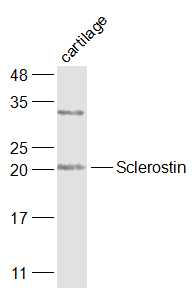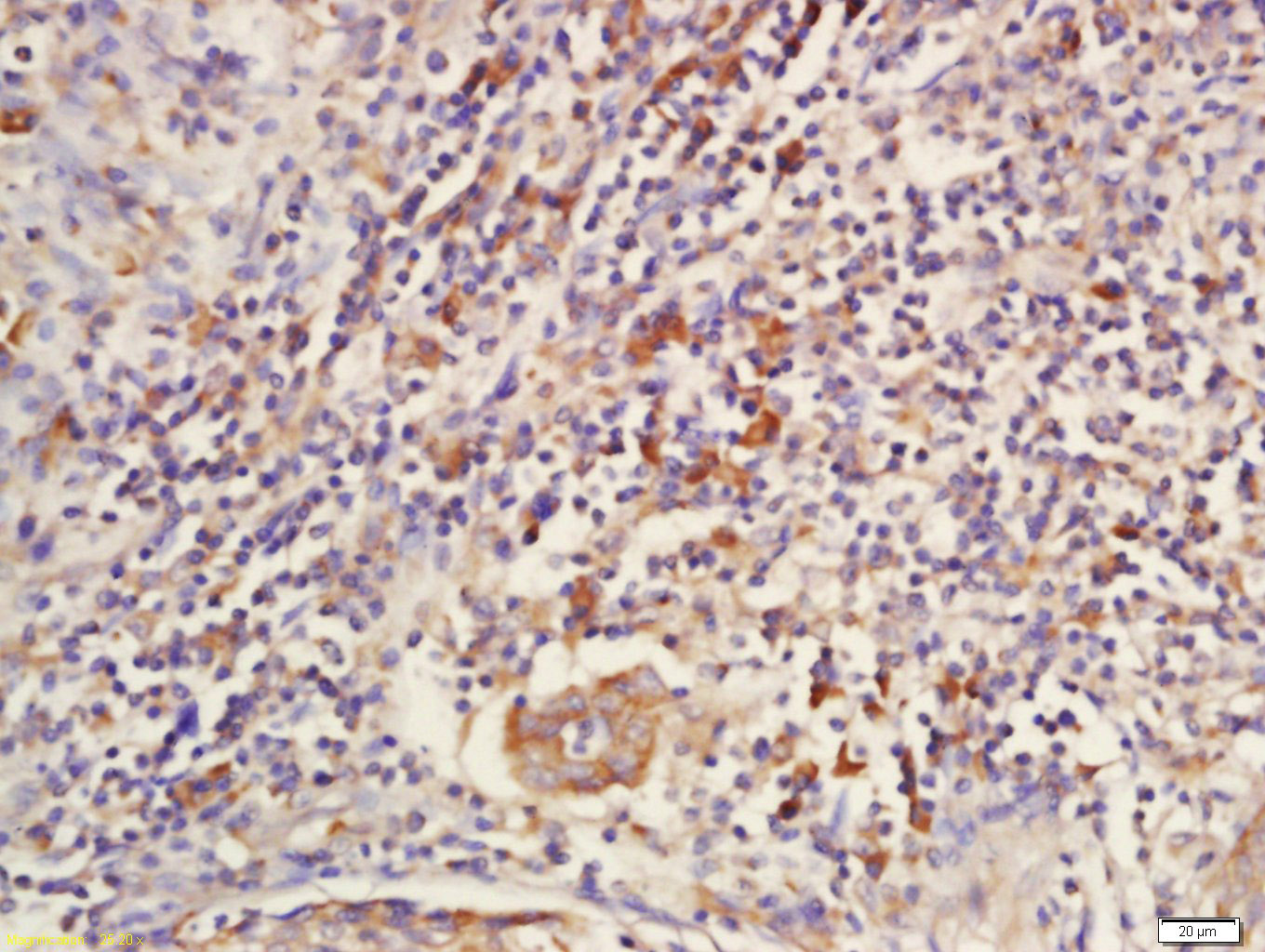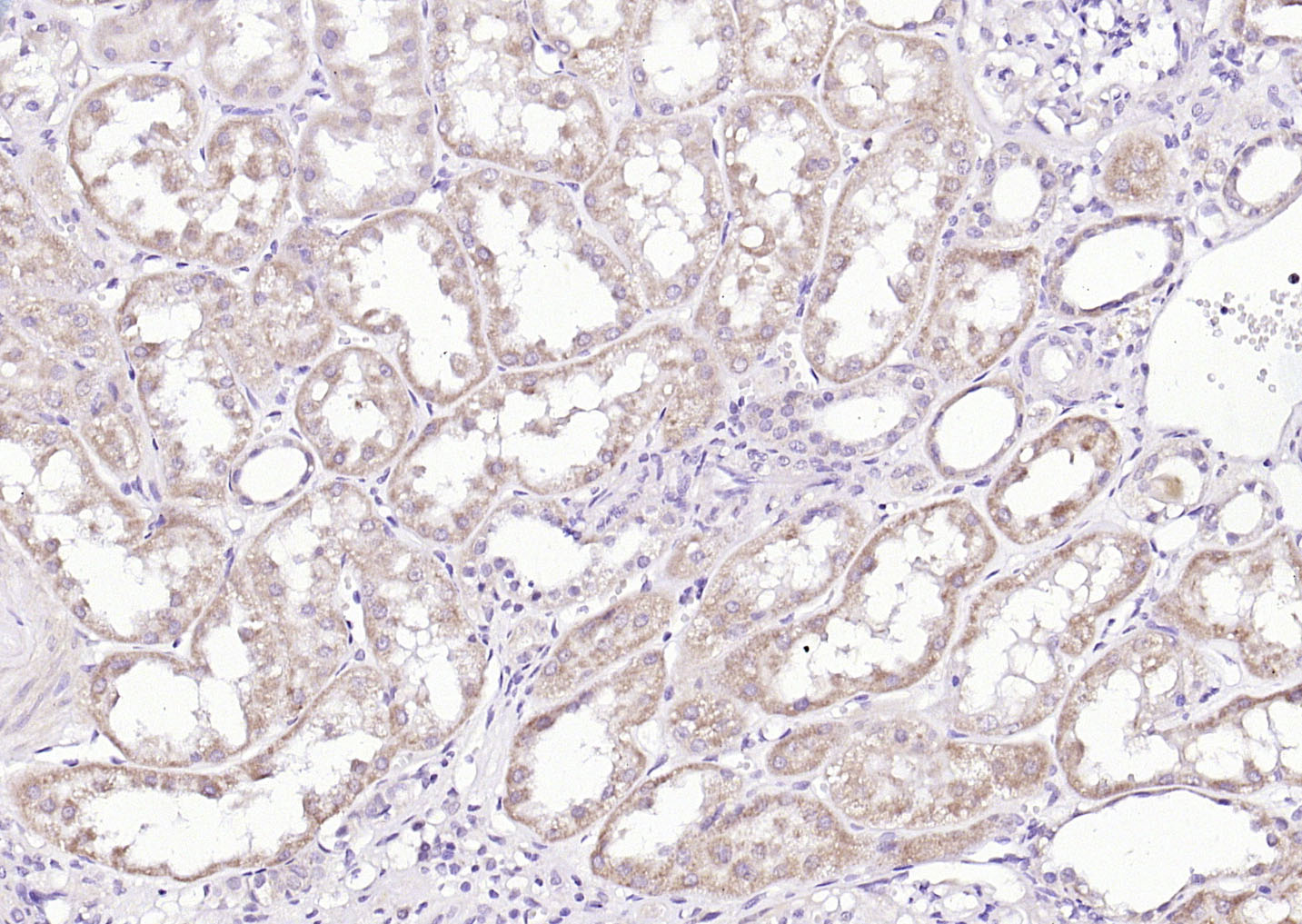
Rabbit Anti-Sclerostin antibody
SOST; BEER; VBCH; Cortical hyperostosis with syndactyly; Sclerosteosis; SOST_HUMAN.
View History [Clear]
Details
Product Name Sclerostin Chinese Name 骨形态发生抑制蛋白SOST抗体 Alias SOST; BEER; VBCH; Cortical hyperostosis with syndactyly; Sclerosteosis; SOST_HUMAN. literatures Research Area Cell biology Signal transduction Growth factors and hormones Immunogen Species Rabbit Clonality Polyclonal React Species Human, Rat, (predicted: Mouse, Dog, Pig, Cow, Horse, Rabbit, Sheep, ) Applications WB=1:500-2000 ELISA=1:5000-10000 IHC-P=1:100-500 IHC-F=1:100-500 ICC=1:100-500 IF=1:100-500 (Paraffin sections need antigen repair)
not yet tested in other applications.
optimal dilutions/concentrations should be determined by the end user.Theoretical molecular weight 21kDa Cellular localization cytoplasmic Form Liquid Concentration 1mg/ml immunogen KLH conjugated synthetic peptide derived from human Sclerostin: 121-180/213 Lsotype IgG Purification affinity purified by Protein A Buffer Solution 0.01M TBS(pH7.4) with 1% BSA, 0.03% Proclin300 and 50% Glycerol. Storage Shipped at 4℃. Store at -20 °C for one year. Avoid repeated freeze/thaw cycles. Attention This product as supplied is intended for research use only, not for use in human, therapeutic or diagnostic applications. PubMed PubMed Product Detail Negative regulator of bone growth.Sclerostin (SOST) is a bone morphogenetic protein (BMP) antagonist, leading to the activation of BMP signaling. It negatively regulates the formation of bone by repressing the differentiation and/or function of osteoblasts induced by BMPs. It has been shown that Sclerostin binds BMP-5, -6, and -7 with high affinity and BMP-2 and -4 with low affinity. The noggin-sclerostin protein complex represents a novel mechanism for the fine-tuning of BMP activity in bone homeostasis. Evidence is accumulating that one of the important mechanisms of bone regulation by sclerostin is the modulation of Wnt/Beta-catenin signaling. Sclerostin also rapidly activated ERK-1/2 MAPK signaling, indicating the involvement of additional signaling pathways
Function:
Negative regulator of bone growth that acts through inhibition of Wnt signaling and bone formation.
Subunit:
Interacts with LRP4 (via the extracellular domain); the interaction facilitates the inhibition of Wnt signaling. Interacts with LRP5 (via the first two YWTD-EGF repeat domains); the interaction inhibits Wnt-mediated signaling. Interacts with LRP6.
Subcellular Location:
Secreted.
Tissue Specificity:
Widely expressed at low levels with highest levels in bone, cartilage, kidney, liver, bone marrow and primary osteeoblasts differentiated for 21 days.
DISEASE:
Defects in SOST are the cause of sclerosteosis (SOST) [MIM:269500]; also known as cortical hyperostosis with syndactyly. SOST is an autosomal recessive sclerosing bone dysplasia characterized by a generalized hyperostosis and sclerosis leading to a markedly thickened skull, with mandible, ribs, clavicles and all long bones also being affected. Due to narrowing of the foramina of the cranial nerves, facial nerve palsy, hearing loss and atrophy of the optic nerves can occur. Sclerosteosis is clinically and radiologically very similar to van Buchem disease, mainly differentiated by hand malformations and a large stature in sclerosteosis patients.
Note=A 52 kb deletion downstream of SOST results in SOST transcription suppression and is a cause of van Buchem disease (VBCH) [MIM:239100]; also known as hyperostosis corticalis generalisata. VBCH is an autosomal recessive sclerosing bone dysplasia characterized by endosteal hyperostosis of the mandible, skull, ribs, clavicles, and diaphyses of the long bones. Affected patients present a symmetrically increased thickness of bones, most frequently found as an enlarged jawbone, but also an enlargement of the skull, ribs, diaphysis of long bones, as well as tubular bones of hands and feet. The clinical consequence of increased thickness of the skull include facial nerve palsy causing hearing loss, visual problems, neurological pain, and, very rarely, blindness as a consequence of optic atrophy. Serum alkaline phosphatase levels are elevated.
Similarity:
Belongs to the sclerostin family. Contains 1 CTCK (C-terminal cystine knot-like) domain.
SWISS:
Q9BQB4
Gene ID:
50964
Database links:Entrez Gene: 50964 Human
Entrez Gene: 74499 Mouse
Omim: 605740 Human
SwissProt: Q9BQB4 Human
SwissProt: Q99P68 Mouse
Unigene: 349204 Human
Unigene: 265602 Mouse
Unigene: 95369 Rat
Product Picture
Cartilage(Rat) Lysate at 40 ug
Primary: Anti-Sclerostin (SL10200R) at 1/1000 dilution
Secondary: IRDye800CW Goat Anti-Rabbit IgG at 1/20000 dilution
Predicted band size: 21 kD
Observed band size: 21 kD
Tissue/cell: human laryngocarcinoma; 4% Paraformaldehyde-fixed and paraffin-embedded;
Antigen retrieval: citrate buffer ( 0.01M, pH 6.0 ), Boiling bathing for 15min; Block endogenous peroxidase by 3% Hydrogen peroxide for 30min; Blocking buffer (normal goat serum,C-0005) at 37℃ for 20 min;
Incubation: Anti-Sclerostin Polyclonal Antibody, Unconjugated(SL10200R) 1:200, overnight at 4°C, followed by conjugation to the secondary antibody(SP-0023) and DAB(C-0010) staining
Paraformaldehyde-fixed, paraffin embedded (Human kidney); Antigen retrieval by boiling in sodium citrate buffer (pH6.0) for 15min; Block endogenous peroxidase by 3% hydrogen peroxide for 20 minutes; Blocking buffer (normal goat serum) at 37°C for 30min; Antibody incubation with (Sclerostin) Polyclonal Antibody, Unconjugated (SL10200R) at 1:200 overnight at 4°C, followed by operating according to SP Kit(Rabbit) (sp-0023) instructionsand DAB staining.Paraformaldehyde-fixed, paraffin embedded (Human kidney); Antigen retrieval by boiling in sodium citrate buffer (pH6.0) for 15min; Block endogenous peroxidase by 3% hydrogen peroxide for 20 minutes; Blocking buffer (normal goat serum) at 37°C for 30min; Antibody incubation with (Sclerostin) Polyclonal Antibody, Unconjugated (SL10200R) at 1:200 overnight at 4°C, followed by operating according to SP Kit(Rabbit) (sp-0023) instructionsand DAB staining.
Partial purchase records(bought amounts latest0)
No one bought this product
User Comment(Total0User Comment Num)
- No comment






 +86 571 56623320
+86 571 56623320




